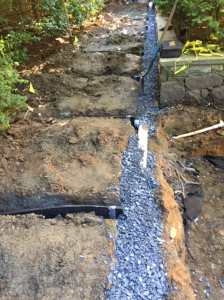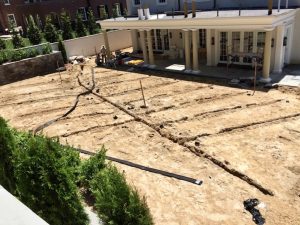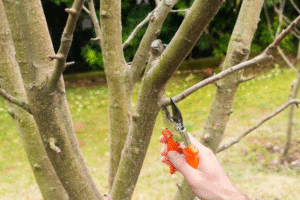Since 2018 provided an astounding record year for precipitation, it seems pertinent in our first newsletter of 2019 to bring up the topic of drainage. This is not the sexy part of landscaping that inspires awe and tickles the senses. Rather it serves a functional purpose to alleviate surface water and hydrostatic pressure away from our homes and outdoor living spaces so residents can enjoy them without hesitation.
Last year was dramatic in respect to precipitation. We saw a record number of events that produced significant results in many properties that have been around for decades, with previously limited issues. And those properties that already had limited drainage issues, realized exacerbated results which at times ended up in catastrophe.
There is no boiler-plate solution as to what are the best drainage solutions for each property. They are always house and site specific. But we’d like to share a few of the methods that we suggest to help keep you enjoying your yard and basement without the threat of erosion, sitting water, or flooding.
First and foremost, you should always have positive drainage away from your home. In layman’s terms, this means that the soil/hardscape against your home should be higher and slope downwards away from the house. Municipalities have different codes as to what is sufficient, but just remember that the steeper the slope and the further the distance away from the house, the less likely your basement will see water. Secondly, tying downspouts into a subsurface pipe system ensures that a large amount of surface area (the entire footprint of your roof) is removed from areas nearest the house. These pipes can then be drawn out to lawn or garden areas where they can be “daylighted” and provide an alternative location for the rain water to vacate. These two practices alone can solve the majority of issues associated with basement water due to heavy precipitation.
In addition to moving water away from a home, large amounts of water in beds and lawns can become a cause for erosion, struggling plant material, and mosquito breeding areas. This can be more than just an aesthetic issue. It becomes costly and potentially provides health hazards to both plants and humans. Some common fixes for these include catch basins, trench drains, French drains, and multi-flow drains.
- Catch basins – Typically a square box with a grate on top, set in a lawn or bed slightly below grade. Water drains to the box with pipes set below the surface, attached to the sides of the box that help the water vacate to another location.
- Trench drain – Similar to a catch basin, but typically longer and skinnier at the top. Often these can be connected in sections to create a longer drain, capturing surface water that is graded towards the trench. This are more commonly used in hardscape areas around pools, patios, and driveways.

- French drain – This is a subsurface drain system that captures surface water through percolation, but is typically not visible at the surface. Essentially a trench is dug and a perforated pipe is installed near the bottom of the trench. The rest of the volume of the trench is then filled with gravel. At the surface, it can be covered with mulch, grass, or stone.
- Multi-flow drainage – Multi flow is a brand name and not necessarily the type of drain, but it has gained enough popularity in the industry that it takes the name of lawn drains similar to how tissues are synonymous with Kleenex. Multi-flow is used in lawn areas where the slope is either flat or at an insignificant enough slope to allow for surface runoff. It is a subsurface drain that is often installed in a fishbone pattern. Its similar to a French drain, however the pipe is taller and skinnier and the trench is backfilled with sand instead of gravel.

In certain municipalities there is a requirement that all of the precipitation hitting impervious surfaces of a property must be drained into a self contained drainage system within the property lines. There are a number of different methods in which this can be achieved. Most commonly infiltration pits, storm chambers, and bio-retention ponds.
- Infiltration pits are a subsurface system whereas other subsurface pipes are drained into the pit. The pit can vary in size, but it will typically be filled with a combination of sand and gravel. Aswater fills the pit, it eventually percolates down into the existing soil and empties the pit.

- Storm chambers are similar to infiltration pits, however there is a rigid plastic or concrete structure within the pit that allows for more volume as it is not being occupied by gravel or sand. Both pits and chambers are covered on top with soil or hardscaping and are not visible from the surface.
- Bio-retention ponds – The last form of on-site water collection. It is essentially a pit dug in a low-lying area that is not backfilled up to the existing grade. The base of the pit typically has layers of sand, gravel, and then mixed soil, allowing for it to be planted with water loving selections. Bio retention ponds, though not subsurface, have the ability to be quite aesthetic if properly installed and maintained.
At Planted Earth, we have many tools in the toolkit to mitigate water issues. Some properties can be alleviated quite easily with a few downspout drains and selective swaling. Others may require full-scale drainage systems with some or all of the items described above. Either way, we would love to have the opportunity to assess your property and help remove the headache of drainage and water issues at your home.




